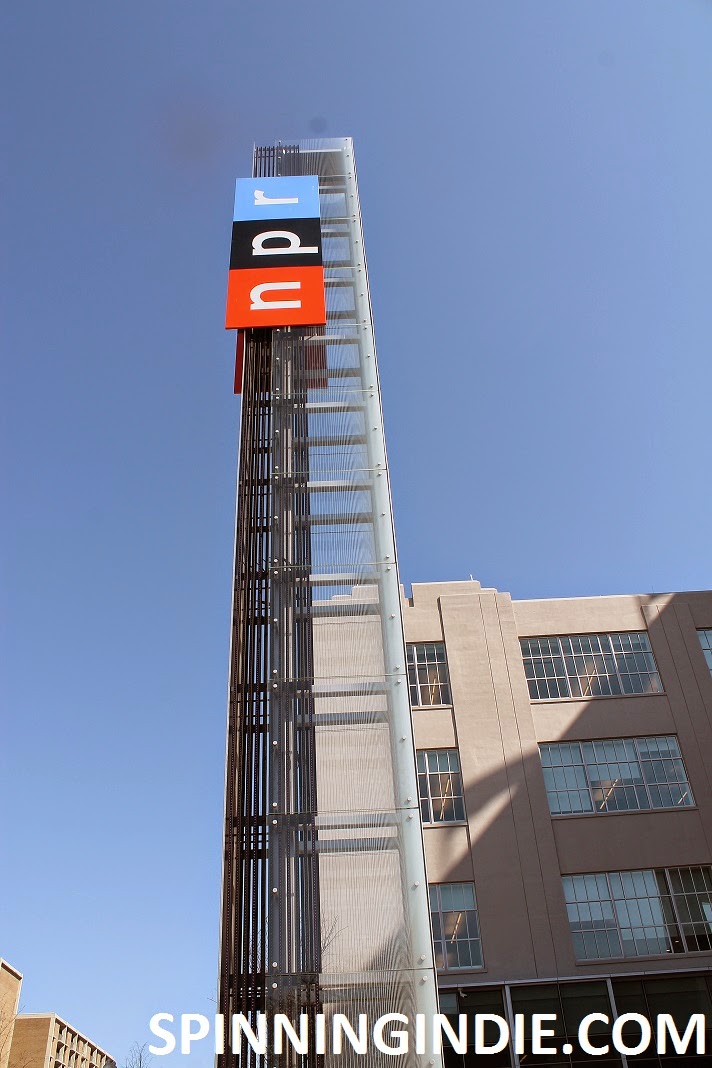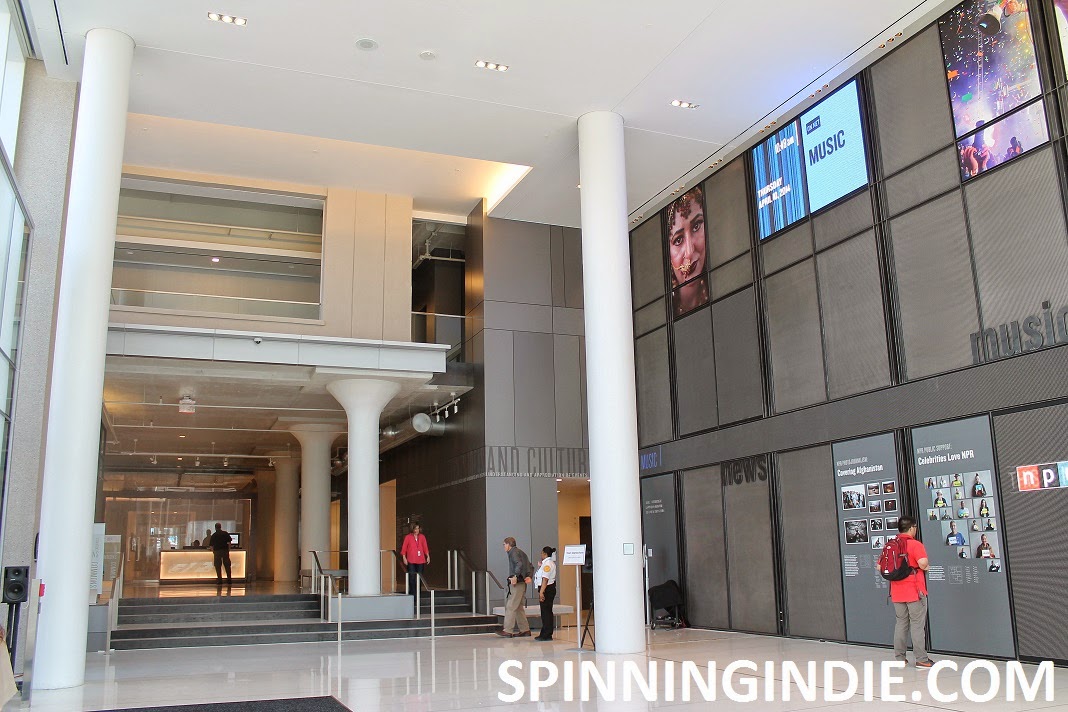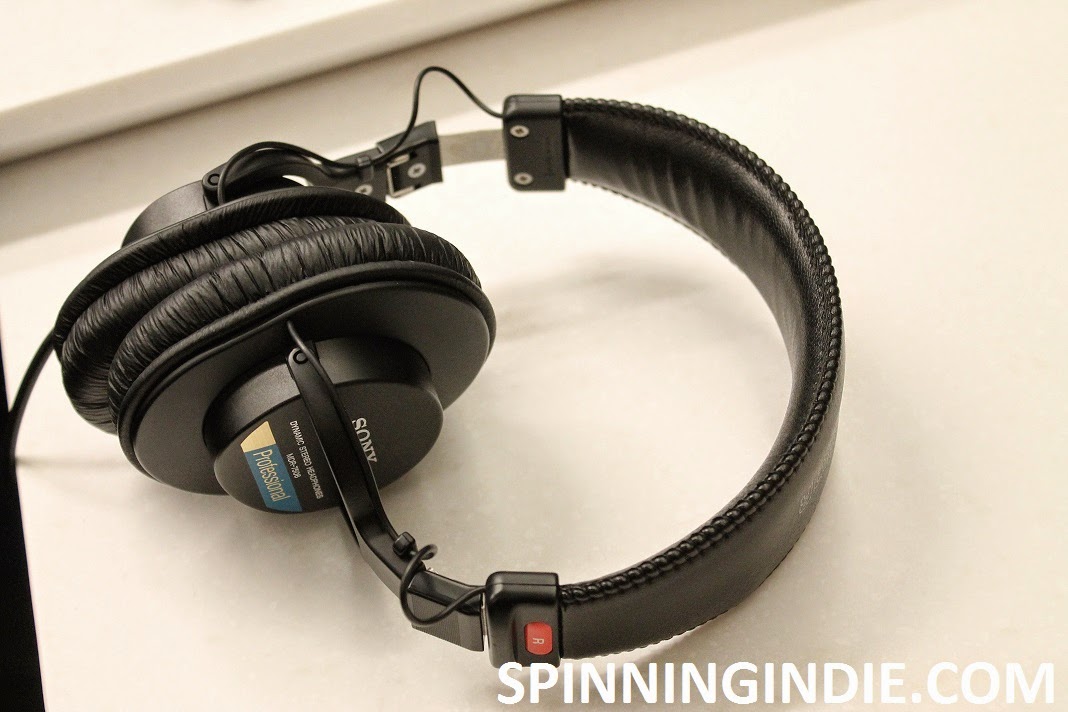 |
| NPR Headquarters. Photo: J. Waits |
While visiting the Washington, D.C. area in April, I took the opportunity to visit NPR‘s new headquarters. Although NPR isn’t technically a radio station, I made an exception for this series, since it is in the business of producing public radio programming.
 |
| NPR Headquarters. Photo: J. Waits |
On April 9, 2014, I joined up with a crowd of NPR fans on a public tour of the gigantic 330,000 square foot facility that houses around 800 employees. Completed just a year before my visit, the building is a modern marvel, crafted out of a 1920s warehouse once used by the local phone company.
 |
| FCC sign outside NPR. Photo: J. Waits |
Before entering the building, I was amused by a large FCC sign to the right of the entrance. Ironic, since NPR doesn’t really have to answer to the Federal Communications Commission (its member stations have to abide by FCC rules), the sign actually referred to a Fire Command Center.
 |
| NPR lobby. Photo: J. Waits |
In advance of my tour, I hung out for a bit in the lobby, watching scrolling headlines and video screens above me and scanning through an illustrated timeline that stretched along one wall. I was glad to see that public radio’s origins on university campuses was highlighted in the display and was also interested in various NPR factoids throughout.
 |
| Exhibit in NPR Lobby. Photo: J. Waits |
National Public Radio was incorporated in 1970 and began with 90 member stations. According to our tour guide, NPR has 975 member stations all over the country today and an annual budget of $175 million, 40% of which comes from member stations and fees.
 |
| Universities get the nod in NPR’s radio history display. Photo: J. Waits |
After congregating in the lobby, our guide led us through various parts of the building. We were told that we could only take pictures in certain locations, so I unfortunately don’t have too many images to share. Apparently many of the NPR staff felt self-conscious about being on display for tour groups, which I can understand. To see the full expanse of the building, take a look at this article in Interior Design and also see the slideshow in this Washington Post story.
 |
| Studio One at NPR. Photo: J. Waits |
Our first stop on the tour was Studio One, a large 2400 square foot multipurpose room that can accommodate live events and performances. There’s hidden bleacher seating for around 250 people, which can be rolled out from the wall. This was one of the few rooms where I was allowed to take photos.
 |
| Wall in Studio One at NPR. Photo: J. Waits |
Next, we traveled up the elevator to an upper floor, where we peeked out the windows to look at the numerous large satellite dishes on the roof for the public radio satellite system as well as for other entities such as FEMA. There’s also a green roof atop the NPR building as well as two beehives (which have their own Twitter feed called @NPRbees, even though they weren’t yet producing honey at the time of my visit).
 |
| NPR Member Station Map in NPR lobby. Photo: J. Waits |
Our next stop was the newsroom. We peered over a balcony in order to look down on staffers going about their day in the “open concept” newsroom. Our tour guide told us that librarians are embedded in each area of the room, providing support to the reporters and producers. It was surprisingly quiet and not at all what I would expect from a bustling news organization. In addition to the news team, NPR digital and social media teams are also located on the lower floor.
 |
| LED sign in NPR lobby. Photo: J. Waits |
We were told that staff are onsite 24 hours a day, 7 days a week. To support the round-the-clock operation, there are sleeping areas, an on-site health facility, and a workout area.
 |
| Headphones in an NPR broadcast studio. Photo: J. Waits |
A huge display of screens with information about audio levels, etc. hovers over the newsroom. Dubbed the MOPS board (Master of Operation Program Support), it’s full of important information for the folks running the shows. Lots of other screens, some airing television news, are are also hanging throughout the space.
 |
| Clock in one of the NPR Broadcast Studios. Photo: J. Waits |
Nearby are green rooms and recording studios and I also saw familiar looking whiteboards with programming information written on them.
 |
| Control room looking into a broadcast studio at NPR. Photo: J. Waits |
I was allowed to take photos again after our guide took us into a spare broadcast studio. It was comprised of two large rooms separated by a big glass window. One room functions as a control room and is typically the domain of the producers, engineers and tech folks, whereas the other room is the studio where hosts and guests would be seated with microphones. I noticed one of the biggest radio station clocks that I’ve ever seen in this room and was told by the tour guide that “everything is time conscious” at NPR.
 |
| A broadcast studio at NPR. Photo: J. Waits |
The control room had a large board and monitors right behind the window, with a second row full of additional seating with monitors and equipment in the back of the room (see photo below). I was amazed by all of the extra computer monitors in the control room, as it was hard to imagine why so many would be needed to control one broadcast out of this room. My guess is that the room is designed to fulfill multiple functions, including ones yet to be imagined.
 |
| One of the control rooms at NPR. Photo: J. Waits |
After leaving the studio, we walked by a darkened Network Operations Center and glanced in through the window. There was an egg chair, which I was told was a sound isolation chair used for listening to content. Engineers staff this room 24 hours a day, ensuring that NPR content is uploading properly. A sign in the room read, “Beware of the Attack Crab,” alluding to the acronym for NPR’s computerized real time automation broadcasting system. A stuffed animal crab was perched atop the egg chair.
 |
| Cough button in a broadcast studio at NPR. Photo: J. Waits |
We also took a quick look into the server room, which is on display to visitors through a glass window near the bank of 2nd floor elevators. A classic Nipper dog sculpture wearing an NPR T-shirt peered out at us.
 |
| Gift Shop at NPR. Photo: J. Waits |
As the tour ended, we were led past a hallway full of awards on display and then taken past the NPR gift shop (yes, there were coffee mugs, along with some hipster baby T-shirts with a cassette tape motif). At this point I asked the tour guide if I could possibly see more.
 |
| CDs at NPR Music. Photo: J. Waits |
I told her that I was a writer and that I’d tried unsuccessfully to get a private tour. I also mentioned that I was hoping to see a specific item that I knew was at Bob Boilen’s desk in the NPR Music department. I’m sure she thought I was a crazed fan, but she made a phone call anyway.
 |
| Turntable and Records at Bob Boilen’s desk at NPR. Photo: J. Waits |
It’s become a quest for me to find handmade radio station signs crafted by an musician named Leo. I’ve seen these 3-D paper mache call letter signs at college and community radio stations all over the country and spotted a few in an article about NPR. Located at Bob Boilen‘s desk (also the home to NPR’s Tiny Desk Concert series), the signs at NPR are special in that there are four of them instead of the usual one with station call letters. They spell out his name, fellow host Robin Hilton’s name, “All Songs Considered,” in addition to the letters NPR.
 |
| Bob Boilen at his desk at NPR. Photo: J. Waits |
After getting approval from upstairs (presumably, in fact, I was told that NPR executives have their offices on the upper floors of the building), we went to Bob Boilen’s desk. It was fun to be in the music/editorial zone at NPR. Nearby shelves were full of books about music and Boilen’s desk was packed with pop culture gems, books, CDs, a transistor radio, a turntable, and vinyl records.
 |
| Steve Keene painting behind Bob Boilen’s desk at NPR. Photo: J. Waits |
His personal bookcases contained a fun array of objects, including toys, books, records, and some Steve Keene paintings (a radio station staple – I saw one at WQHS this year too). This area forms the backdrop for the Tiny Desk concert series, so these items are probably familiar to fans of the video series.
| “Leo” signs atop bookcases at NPR. Photo: J. Waits |
Thankfully I spotted the hoped-for Leo Blais signs atop his shelves, emblazoned with “NPR,” “Bob Boilen,” “Robin Hilton” and “All Songs Considered.” After snapping some photos and leaving a KFJC sticker on the shelf (with Boilen’s blessing), I was on my way. Months after my visit I was pleased to see the sticker in the background of some live performances at NPR.
 |
| Can you spot the KFJC sticker? Photo: J. Waits |
Thanks so much to my guide Cathy for the tour of NPR and big thanks to Bob Boilen for allowing me to see his lair so that I could add a few more Leo signs to my virtual scavenger hunt.
 |
| More fun artifacts at Bob Boilen’s desk at NPR. Photo: J. Waits |
My Spring 2014 station tours are nearly completed! I have one more college radio station visit in Maryland to write up in addition to a high school station in Illinois. Following that, I’ll post my fall 2014 Seattle and San Francisco station visits. You can see a complete list of all of my Spinning Indie Radio Station Field Trips here.
This post originally appeared on my blog Spinning Indie.


